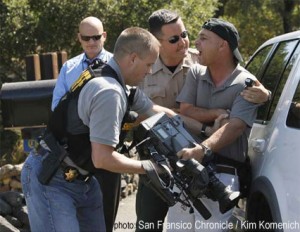 Do public safety personnel have the authority to stop people from taking photos at emergency scenes? Does it matter whether the filming is being done by the media or ordinary citizens? Perhaps as a result of the wide spread use of digital and cellphone cameras, these questions continue to resurface time and time again.
Do public safety personnel have the authority to stop people from taking photos at emergency scenes? Does it matter whether the filming is being done by the media or ordinary citizens? Perhaps as a result of the wide spread use of digital and cellphone cameras, these questions continue to resurface time and time again.
Last week, the United States 1st Circuit Court of Appeals reaffirmed that public safety personnel have absolutely no right to interfere with photo taking by the media or citizens in public places, and that they could be held liable for violating the First Amendment Rights of the photographers.
The case involved Boston police officers who arrested an ordinary citizen, Simon Glik, for video recording their rough handling of a suspect. The officers ordered Glik to stop taking photos and when he refused, he was arrested for disturbing the peace and violating a state law that prohibits secretly recording a conversation. According to police, Glik’s video recording included audio, which they claim made it an illegal “clandestine” (secret) recording.
The criminal charges against Glik were eventually dropped, but he opted to file suit in Federal court against the officers for violation of his 1st Amendment Rights. The officers sought to have the case dismissed claiming they were entitled to qualified immunity. One of the central issues in the case was whether or not the officers violated a “clearly established constitutional right”.
In writing the opinion, Judge Kermit V. Lipez cited dozens of 1st Amendment cases that clearly explain that the media and ordinary citizens have an absolute right to film governmental officials doing their work in public places. He also cited cases holding that ordinary citizens have just as broad a right to gather news as the traditional media, and government cannot unreasonably restrict the exercise of that right.
Judge Lipez concluded: “though not unqualified, a citizen’s right to film government officials, including law enforcement officers, in the discharge of their duties in a public space is a basic, vital, and well-established liberty safeguarded by the First Amendment.”
As Judge Lipez noted, the right to take photos is not without limitation. It is subject to “reasonable time, place, and manner restrictions”. While the decision did not discuss the boundaries of those restrictions, they are important for us to recognize and understand. First of all, photographers must be in a publicly accessible location. They have no right to enter into someone’s home, onto private property, or be granted access into restricted areas, such as the back of an ambulance. Secondly, the right does not allow photographers to interfere with operations. Third, photographers must respect reasonable hazard/safety exclusion zones that are set up.
Nothing in the 1st Amendment case law prohibits emergency responders from physically standing in such a way as to block the line of vision of a would-be photographer, or even erecting barriers (with blankets or sheets) to shield a patient from glare of cameras. Such actions may be entirely appropriate for responders when matters of patient confidentiality are an issue.
However, at no time should they attempt to stop someone from filming, physically restrain them, or attempt to turn off or take their camera equipment. The public has a “well established 1st Amendment Right” to take photos and video at incident scenes.
Here is a copy of the Glik decision. Glik_Boston_Video Incidentally, Judge Lipez is well known as a brilliant legal scholar and does an excellent job of explaining the state of the law in a way that even non-lawyers can understand.
An interesting web site that chronicles issues with photographers being stopped from taking photos and videos is Photography is Not a Crime.